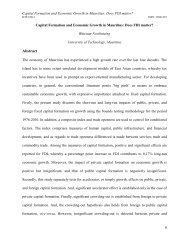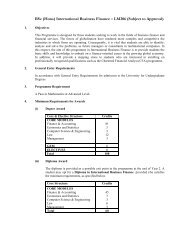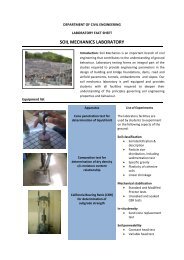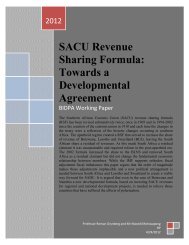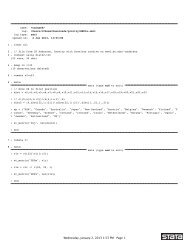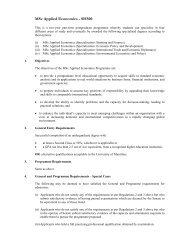A Theoretical Foundation for the Gravity Equation
A Theoretical Foundation for the Gravity Equation
A Theoretical Foundation for the Gravity Equation
You also want an ePaper? Increase the reach of your titles
YUMPU automatically turns print PDFs into web optimized ePapers that Google loves.
110 THE AMERICAN ECONOMIC REVIEW MARCH 1979<br />
many tradeables <strong>for</strong> each country, with<br />
tariffs and transport costs present, but initially,<br />
as be<strong>for</strong>e, assume only one tradeable<br />
in each and no barriers to trade. The system<br />
to be estimated is<br />
(5') M = Oj0 Yj Uj,<br />
(6') m1i bY, = Oi 01Yi<br />
i<br />
where Uii is a log-normal disturbance with<br />
E(/n Uij) = 0. Note that (6') states that<br />
planned expenditures (reduced or increased<br />
by <strong>the</strong> capital account factor) = planned<br />
sales, and has no error term. Efficient estimation<br />
requires that <strong>the</strong> in<strong>for</strong>mation in (6')<br />
be utilized. The most convenient way to do<br />
this, since <strong>the</strong> constraint is highly nonlinear<br />
in <strong>the</strong> Y's, is to substitute out Oi and<br />
estimate <strong>the</strong> gravity equation:<br />
(8) M i =<br />
m(Yi, Ni)F(Yi, Nj YiF(Yj, Nj) Yj<br />
ZF(Yj,Nj)Y J<br />
With <strong>the</strong> log-linear <strong>for</strong>m <strong>for</strong> m( ) and F( ),<br />
and<br />
m(Yi, N) = km YTYNTN<br />
F(Yj,Nn) = k?,H': Nj<br />
and <strong>the</strong> denominator made a constant term<br />
we have<br />
(8') Mij = (km YYNy N )(kX Y/+YN/iN)Y<br />
* (k,l y+NjN) YjUij k'<br />
=<br />
(kmk,) Y+myY+' N7mN+'PN<br />
* OY + l<br />
YI N OfjN j Ui .k' k<br />
This is <strong>the</strong> aggregate <strong>for</strong>m of (1) with <strong>the</strong><br />
distance term omitted. Ordinarily it would<br />
be fitted on a subset of countries in <strong>the</strong><br />
world. Exports to <strong>the</strong> rest of <strong>the</strong> world are<br />
exogenous and imports from it are excluded<br />
from <strong>the</strong> fitting. When this is done, <strong>the</strong> denominator<br />
is still <strong>the</strong> sum of world trade<br />
expenditures, and (6') implies that (8) and<br />
(8') assume that Oi is <strong>the</strong> same in <strong>the</strong> excluded<br />
countries as in <strong>the</strong> included countries.<br />
Alternatively, (6') can be interpreted<br />
as a payments union multilateral balance<br />
constraint (which includes as a special case<br />
<strong>the</strong> rest of <strong>the</strong> world account being always<br />
zero). The denominator of (8) and (8') <strong>the</strong>n<br />
has only <strong>the</strong> included group's trade expenditure.8<br />
Under ei<strong>the</strong>r interpretation, <strong>the</strong><br />
identifying restrictions immediately allow<br />
recovery of all structural exponents from<br />
<strong>the</strong> estimator of (8'). Ei<strong>the</strong>r interpretation<br />
will also permit <strong>the</strong> complex constant term<br />
(km kl/k') to be unravelled, though <strong>the</strong><br />
estimators kmin kO<br />
, k' have only large sample<br />
unbiasedness.9 Finally, <strong>for</strong>m <strong>the</strong> set of estimated<br />
values <strong>for</strong> traded-goods expenditures:<br />
(9) fj Yj = k/ Yky+I NjN<br />
The individual traded-goods shares 0<br />
can be estimated using <strong>the</strong> instruments $^<br />
(which are asymptotically uncorrelated with<br />
Ujj):<br />
8If nei<strong>the</strong>r of <strong>the</strong>se alternatives is palatable, exports<br />
to <strong>the</strong> rest of <strong>the</strong> world can be fixed at Mi,n+ 1. Trade<br />
balance is now<br />
(a)<br />
miqi Yi = Oil k1 Y1 + Mi,n+ I<br />
I<br />
When <strong>the</strong> trade balance is solved <strong>for</strong> Qi and substituted,<br />
<strong>the</strong> gravity equation is<br />
(b) M (Mi0i Yi Min+ l) )?jYj<br />
Z ki i<br />
Non-linear methods must be used to estimate (b).<br />
9Consider <strong>the</strong> worldwide identity of preferences<br />
case. Using conditional expectations in (6'), <strong>the</strong> trade<br />
balance requirement implies that<br />
kmkl y l Yy+myN 4mN = E E(Mi) + M I<br />
1= 1<br />
where Mi,n+ I is <strong>the</strong> exogenous nonrandom export<br />
of i to <strong>the</strong> rest of <strong>the</strong> world. Replacing E(Mij) with its<br />
solved values M1j, and <strong>the</strong> exponents with <strong>the</strong>ir estimated<br />
values, we have<br />
(a)<br />
kmk= [Z ^1] i + Min - N i<br />
J= 1<br />
Using <strong>the</strong> definition of k', we have<br />
(b) k' = k,(Z YJ$YN $N) + E<br />
Finally <strong>the</strong> estimated constant term k, is <strong>the</strong>oretically<br />
related to <strong>the</strong> three constants km, k,0, k' by<br />
(c)<br />
k = kmk2/k'<br />
(a)-(c) can be solved explicitly <strong>for</strong> <strong>the</strong> three constants<br />
kmi ko, k'.<br />
This content downloaded on Thu, 3 Jan 2013 15:32:06 PM<br />
All use subject to JSTOR Terms and Conditions




